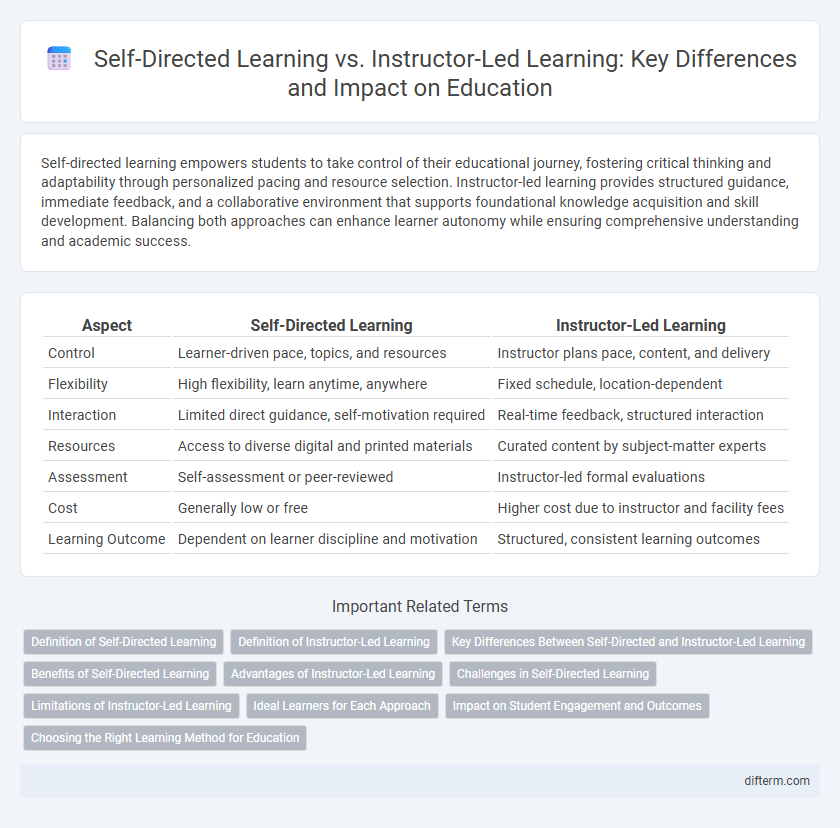Self-directed learning empowers students to take control of their educational journey, fostering critical thinking and adaptability through personalized pacing and resource selection. Instructor-led learning provides structured guidance, immediate feedback, and a collaborative environment that supports foundational knowledge acquisition and skill development. Balancing both approaches can enhance learner autonomy while ensuring comprehensive understanding and academic success.
Table of Comparison
| Aspect | Self-Directed Learning | Instructor-Led Learning |
|---|---|---|
| Control | Learner-driven pace, topics, and resources | Instructor plans pace, content, and delivery |
| Flexibility | High flexibility, learn anytime, anywhere | Fixed schedule, location-dependent |
| Interaction | Limited direct guidance, self-motivation required | Real-time feedback, structured interaction |
| Resources | Access to diverse digital and printed materials | Curated content by subject-matter experts |
| Assessment | Self-assessment or peer-reviewed | Instructor-led formal evaluations |
| Cost | Generally low or free | Higher cost due to instructor and facility fees |
| Learning Outcome | Dependent on learner discipline and motivation | Structured, consistent learning outcomes |
Definition of Self-Directed Learning
Self-directed learning is an educational approach where learners take the initiative to identify their learning needs, set goals, and independently seek resources and strategies to acquire knowledge. This method emphasizes autonomy, critical thinking, and self-motivation, contrasting with instructor-led learning, which relies on structured guidance from educators. In self-directed learning, responsibility for progress and outcome rests primarily on the learner, fostering lifelong learning skills and adaptability.
Definition of Instructor-Led Learning
Instructor-led learning (ILL) is a traditional educational approach where a qualified instructor guides students through structured lessons in real time, either in-person or virtually. This method emphasizes direct interaction, immediate feedback, and a set curriculum designed to meet specific learning outcomes. ILL is often preferred for complex subjects requiring expert explanation, collaboration, and disciplined pacing.
Key Differences Between Self-Directed and Instructor-Led Learning
Self-directed learning emphasizes learner autonomy, allowing students to set their own pace, goals, and strategies, while instructor-led learning follows a structured curriculum with guided instruction and scheduled interaction. Self-directed learners often develop critical thinking and problem-solving skills through exploration, whereas instructor-led environments provide immediate feedback and clarification from experts. The choice between these methods depends on learner motivation, content complexity, and desired learning outcomes, with self-directed learning suited for highly motivated individuals and instructor-led learning beneficial for foundational knowledge acquisition.
Benefits of Self-Directed Learning
Self-directed learning empowers individuals with autonomy, allowing learners to tailor educational experiences to their unique needs and pace, which enhances motivation and retention. This approach fosters critical thinking and problem-solving skills by encouraging exploration and self-assessment. Studies show that self-directed learners exhibit higher engagement and adaptability in dynamic learning environments compared to traditional instructor-led models.
Advantages of Instructor-Led Learning
Instructor-led learning offers structured guidance that ensures consistent delivery of curriculum aligned with educational standards, promoting better comprehension and retention. Real-time interaction with instructors allows immediate feedback, clarification of complex concepts, and personalized support tailored to individual learning needs. This method fosters a collaborative learning environment, enhancing motivation and engagement through direct social interaction and peer discussions.
Challenges in Self-Directed Learning
Self-directed learning poses significant challenges such as maintaining motivation, managing time effectively, and overcoming the lack of immediate feedback compared to instructor-led learning environments. Learners must develop strong self-regulation and critical thinking skills to navigate complex materials independently. This mode of learning often requires robust digital literacy and access to reliable resources to ensure successful knowledge acquisition without direct instructor guidance.
Limitations of Instructor-Led Learning
Instructor-led learning often limits learner autonomy, reducing opportunities for personalized pacing and exploration of topics. Fixed schedules and standardized curricula can restrict flexibility, hindering engagement and adaptation to individual learning styles. This traditional model may also delay feedback and limit real-time interaction, impacting knowledge retention and skill development.
Ideal Learners for Each Approach
Self-directed learning suits motivated, independent individuals who thrive on autonomy and personalized pacing, enhancing critical thinking and problem-solving skills. Instructor-led learning benefits learners needing structured guidance, immediate feedback, and collaborative opportunities for mastering complex concepts. Understanding these ideal learner profiles helps optimize educational outcomes by aligning teaching methods with learner preferences and abilities.
Impact on Student Engagement and Outcomes
Self-directed learning empowers students to take ownership of their educational journey, fostering higher intrinsic motivation and personalized pace, which often leads to improved critical thinking and problem-solving skills. Instructor-led learning provides structured guidance and immediate feedback, enhancing comprehension and retention, particularly in complex or foundational subjects. Combining both approaches can optimize student engagement and outcomes by addressing diverse learning preferences and promoting active participation.
Choosing the Right Learning Method for Education
Self-directed learning empowers students to tailor their education to personal goals, pace, and interests, fostering autonomy and critical thinking. Instructor-led learning provides structured guidance, expert feedback, and a collaborative environment that can enhance comprehension of complex subjects. Selecting the appropriate learning method depends on individual learning styles, the subject complexity, and the desired outcomes for knowledge retention and skill application.
Self-directed learning vs Instructor-led learning Infographic

 difterm.com
difterm.com